Megastructures
One of the intriguing possibilities offered by science fiction is the exploration of structures and structural concepts that lie well beyond our ability to construct. These artificial structures are often vast to an extent we struggle to comprehend. So what types of such mega- or macro-structures do we see in science fiction, and why do they fascinate us so?
Cities of the Future
Most human buildings typically extend no more than tens of metres in any dimension. Rare examples extend that to hundreds of metres, with some shopping centres, airport terminals, giant factories, exhibition centres and similar boasting individual buildings extending of order a kilometre (1000m) in width, length or both. Some vehicle factories, for example, have buildings with a floor area of close on 1000x1000=1 million square metres. The world’s tallest building is on a similar scale, with the Burj Khalifa skyscraper in Dubai reaching a height of 828 metres, although with a far smaller footprint on the ground.
In cities with high population density, it is not unusual to see efforts at combining living space with shopping and even industrial spaces, usually on different floors of a tall building. These were seen as new and exciting, reaching a peak in popularity in the mid to late twentieth century, before enthusiasm waned. The idea of such large tower cities inevitably found its way into science fiction, for example in the 350(!) storey Thompson Tower in Thunderbirds episode "City of Fire" (TV, 1966).
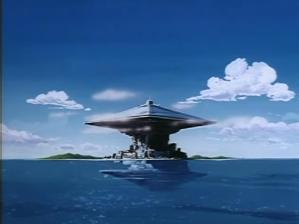 An extension of this concept is an arcology - an integrated single-building city architectural proposed by Paolo Soleri in 1969. Integral to the concept of arcologies is that they aim to be self-contained, minimising the impact of human presence outside the building itself. Arcologies appear in science fiction novels such as Oath of Fealty (Larry Niven & Jerry Pournell, 1981), Neuromancer (Gibson, 1984) and even in the anime Science Rescue Team Technoboyager (TV, 1982, aka Thunderbirds 2086) where an ocean-sited arcology forms the home base of the International Rescue Organisation. Because of their commitment to compact and efficient living, arcologies in fiction are large structures, but have a significantly smaller area than the cities they replace, with dimensions of a few kilometres on a side rather than tens of kilometres. However, as is the case with vertical cities, attempts to implement the concept in the real world have met with limited success, for a variety of practical, economic and human reasons.
An extension of this concept is an arcology - an integrated single-building city architectural proposed by Paolo Soleri in 1969. Integral to the concept of arcologies is that they aim to be self-contained, minimising the impact of human presence outside the building itself. Arcologies appear in science fiction novels such as Oath of Fealty (Larry Niven & Jerry Pournell, 1981), Neuromancer (Gibson, 1984) and even in the anime Science Rescue Team Technoboyager (TV, 1982, aka Thunderbirds 2086) where an ocean-sited arcology forms the home base of the International Rescue Organisation. Because of their commitment to compact and efficient living, arcologies in fiction are large structures, but have a significantly smaller area than the cities they replace, with dimensions of a few kilometres on a side rather than tens of kilometres. However, as is the case with vertical cities, attempts to implement the concept in the real world have met with limited success, for a variety of practical, economic and human reasons.
However the idea of a compact, self-contained city does come with some advantages. Christopher Priest effectively mounted an arcology on wheels in his Inverted World (novel, 1974), in which a population live in a single-construct city which is eternally in motion [1]. However unlike the true arcology concept, Priest’s city cannot be said to minimise its impact. Crews are forced to lay rails in front of the city’s vast tracks, and to pull them up behind so the city scars the landscape as it moves past in search of the elusive “optimum”.
Cities in the Stars
Really large constructions, however, will always be hampered by the gravity of Earth or similar planets. To move up to scales of tens of kilometres, we must start to look into space. Most spaceships in science fiction fall well below this scale [2]. Domed cities on asteroids or moons in some fiction may extend over regions of kilometres or tens of kilometres, but arguably fall in a grey area regarding whether they could reasonably be considered a single structure, rather than enclosing an environment in which structures can be built.
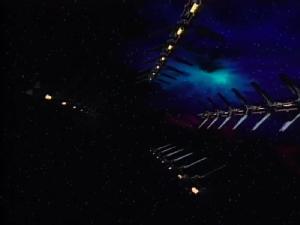 As is the case on Earth now, some of the largest space constructs in science fiction serve utilitarian purposes. In the Halo video game franchise (first released 2001), the titular haloes are ancient and powerful space-borne weapons tens of kilometers in diameter. Perhaps slightly more routine in nature, albeit more speculative, are some of the constructions that have been proposed to act as hyperspace portals for faster than light travel. The jumpgates in Babylon 5 (TV series, 1993), for example, are formed of four long pylons which focus energy on a “jump point” where space and the hypothetical hyperspace come into contact, allowing vessels to pass through. They also act as a navigational network, providing beacons those same vessels can follow. Much the same purpose is served by the ring gate network in The Expanse series (novels, Corey, 2011-; TV, 2015-), which describes the gates as about 1000km in size.
As is the case on Earth now, some of the largest space constructs in science fiction serve utilitarian purposes. In the Halo video game franchise (first released 2001), the titular haloes are ancient and powerful space-borne weapons tens of kilometers in diameter. Perhaps slightly more routine in nature, albeit more speculative, are some of the constructions that have been proposed to act as hyperspace portals for faster than light travel. The jumpgates in Babylon 5 (TV series, 1993), for example, are formed of four long pylons which focus energy on a “jump point” where space and the hypothetical hyperspace come into contact, allowing vessels to pass through. They also act as a navigational network, providing beacons those same vessels can follow. Much the same purpose is served by the ring gate network in The Expanse series (novels, Corey, 2011-; TV, 2015-), which describes the gates as about 1000km in size.
Amongst the most common proposed true single-structure constructs on scales of tens of kilometres are space colonies, and in particular O’Neill Cylinders (rotating cylindrical constructs which rotate around their central axis to simulate gravity, and which I've discussed before). Examples of these, including the eponymous station in Babylon 5 and interstellar spaceship in Rendezvous with Rama (novel, Clarke, 1973), extend from a few kilometres to 50 kilometres or more in length. Similarly some space stations with more complex geometries (such as spinning wheel stations, toroids and others) are of comparable size, although these are relatively rare - Star Trek’s Deep Space Nine, for example, is canonically less than a kilometre and a half in diameter.
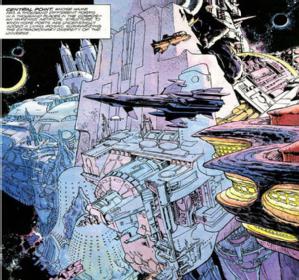 Evolving more organically are a number of other large-scale space stations in science fiction. The opening sequence of the film Valerian and the City of a Thousand Planets (2017, dir. Besson), for instance, shows successive modules added to the International Space Station over the next few centuries, originally representing disparate Earth nations and then contributions by other alien species. The resulting complex multi-modular space station eventually reaches a mass so great that it is pushed out of orbit and into “the Magellan current” where it continues to grow, developing zones with different environments and physical conditions. The film is is set four centuries after the opening sequence, on the vast construct now named Alpha. The film was based on the well-known French language Valérian et Laureline science-fiction comics by Christin and Meziérès written in the 1970s and 80s, and most closely on the story "Ambassador of the Shadows" (1975), which featured the similarly agglomerated Point Central station.
Evolving more organically are a number of other large-scale space stations in science fiction. The opening sequence of the film Valerian and the City of a Thousand Planets (2017, dir. Besson), for instance, shows successive modules added to the International Space Station over the next few centuries, originally representing disparate Earth nations and then contributions by other alien species. The resulting complex multi-modular space station eventually reaches a mass so great that it is pushed out of orbit and into “the Magellan current” where it continues to grow, developing zones with different environments and physical conditions. The film is is set four centuries after the opening sequence, on the vast construct now named Alpha. The film was based on the well-known French language Valérian et Laureline science-fiction comics by Christin and Meziérès written in the 1970s and 80s, and most closely on the story "Ambassador of the Shadows" (1975), which featured the similarly agglomerated Point Central station.
[Image: Point Central illustrated by Jean-Claude Mézières in the Valerian and Laureline comics]
The same basic premise can be found in other gradually-evolving space-borne megastructures. In The Tomorrow People (TV, 1973-1979), the Galactic Federation is governed and administered from a colossal space station known as the Galactic Trig [3]. In the tie-in book Four Into Three (Price, 1975) it is described as a “gigantic complex of interlinked satellites, lit by its own artificial suns” (pg 76). By contrast the similar space station in James White’s Sector General novel series (1962-1999, short stories from 1957) is used as a hospital. In both cases, the structures are huge and modular in nature, with different sections added at different times, and each supporting a different environment or set of living quarters for a different alien race. As described in the first Sector General story (“O’Mara’s Orphan”, 1960):
“Hundreds of different environments would be accurately reproduced here, any extreme of heat, cold, pressure, gravity, radiation or atmosphere necessary for the patients and staff it would contain. Such a tremendous and complex structure was far beyond the resources of any one planet, so that hundreds of worlds had each fabricated sections of it and transported them to the assembly point. But fitting the jigsaw together was no easy job.”
The scale of these stations is unclear but appears to extend beyond the kilometre scale to at tens and probably hundreds of kilometres, perhaps even approaching planetary sizes or volumes.
Putting the Mega into Megastructure
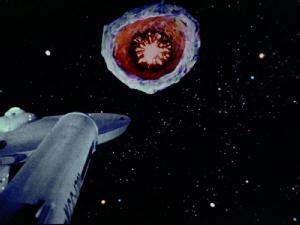 While there is no universally accepted definition of megastructures, one proposal is that they should be on scales of a megametre - 1000 kilometers or a million metres. This requires constructs on a scale comparable to large natural moons or planets. Perhaps inevitably, weapons feature amongst the speculative fictions of structures o this scale. The eponymous device in Star Trek episode “The Doomsday Machine” (TV, 1967) is a planet-scaled horn of dense material which engulfs planets at one end and processes their debris for fuel. It is attracted by energy output. The origin of this device appears to be outside the Galaxy and while Captain Kirk speculates that it was created as a mutually-assured-destruction doomsday weapon, the reasons for its original construction remain unknown, as does the risk of other such devices existing. The crew of the Enterprise must simply destroy the machine in the hope that it was a unique threat.
While there is no universally accepted definition of megastructures, one proposal is that they should be on scales of a megametre - 1000 kilometers or a million metres. This requires constructs on a scale comparable to large natural moons or planets. Perhaps inevitably, weapons feature amongst the speculative fictions of structures o this scale. The eponymous device in Star Trek episode “The Doomsday Machine” (TV, 1967) is a planet-scaled horn of dense material which engulfs planets at one end and processes their debris for fuel. It is attracted by energy output. The origin of this device appears to be outside the Galaxy and while Captain Kirk speculates that it was created as a mutually-assured-destruction doomsday weapon, the reasons for its original construction remain unknown, as does the risk of other such devices existing. The crew of the Enterprise must simply destroy the machine in the hope that it was a unique threat.
The short story "Devourer" by Cixin Liu (originally published 2002) features a conceptually similar device. Rather than a tube, this is in the form of a ring that passes around planets with destructive effects. Liu’s philosophical approach to science fiction here manifests in the form of a dialogue between the people of Earth and the occupants of the ring, challenging the selfishness of their resource consumption at the expense of others.
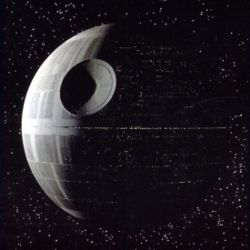 Of course, probably the most famous destructive megastructure can be found in Star Wars (film, 1977, dir. Lucas). The Imperial Deathstar was a spherical construct several hundred kilometres in diameter in this narrative, but, as we were famously told, “that’s no moon, that’s a space station!”. The smaller prototype seen in Star Wars: A New Hope housed a large laser weapon which entirely shattered the planet Alderaan for purely military processes rather than with any view to processing its resources. The larger Death Star seen under construction in Star Wars: Return of the Jedi approached a thousand kilometres across, placing it firmly in the megastructure category.
Of course, probably the most famous destructive megastructure can be found in Star Wars (film, 1977, dir. Lucas). The Imperial Deathstar was a spherical construct several hundred kilometres in diameter in this narrative, but, as we were famously told, “that’s no moon, that’s a space station!”. The smaller prototype seen in Star Wars: A New Hope housed a large laser weapon which entirely shattered the planet Alderaan for purely military processes rather than with any view to processing its resources. The larger Death Star seen under construction in Star Wars: Return of the Jedi approached a thousand kilometres across, placing it firmly in the megastructure category.
However not all megastructures are necessarily hostile. In both “Umbrella in the Sky” by E C Tubb (short story, 1961) and Sunstorm by Clarke & Baxter (novel, 2005) , for example, a sunshade is constructed to protect Earth from the threat of solar instability. The necessary artefacts are of enormous dimensions (“ten thousand miles in diameter” in the case of "Umbrella in the Sky" and larger in diameter than the Earth in Sunstorm), and the stories address the difficulty of maintaining the commitment and concentration of the men during the colossal task of building it, as well as the sacrifice involved. In Sunstorm, Clarke and Baxter address the difficulty of maintaining the physical structure of such a vast construct - their sunshield not only lends itself support through a slow rotation but also requires the active intervention of a sentient artificial intelligence to balance the forces and motions of the shield against the dynamic solar wind from our Sun.
By contrast, Douglas Adams’ science fiction comedy The Hitchhikers Guide to the Galaxy (BBC radio, 1978) imagines many planets themselves, including Earth, as the results of a custom planet-building industry hosted by the planet Magrathea. Here hyperspatial engineering and similarly incomprehensible technologies are invoked in the manufacture process. Perhaps more practical, albeit still beyond our capacities are the vast structures which form rings around planets - usually as a result of linking an existing belt of orbiting stations into a continuous chain, as seen for example in Neal Stephenson's SevenEves (2015), in Alistair Reynolds' Revelation Space (2001), in Arthur C Clarke's The Fountains of Paradise (1979) or 3001: The Final Odyssey (1997), and in the Star Trek: SCE ebook Ring Around the Sky (Gibson, 2004).
Stepping up to orbital scales - i.e. not just embracing a planet but potentially surrounding its host star - we find another class of macrostructures. These are structures built by deconstructing entire planets or asteroid belts and refining them into more useful configurations that maximise both usable surface area and the ability to capture solar energy over it. Proposed by physicist Freeman Dyson in 1960, a spherical structure surrounding the Sun at the same distance as Earth’s orbit would have a diameter of 2 astronomical units, or 300 million kilometres. More importantly, it would have a surface area a hundred million times that of Earth, all potentially in the Sun’s habitable zone (a distance where the irradiation from the Sun can maintain liquid water), and would capture the Sun’s full energy output rather than the 0.00000005% that currently reaches Earth [4]. Indeed, this energy would arguably be required to achieve planetary engineering on the scale required.
Such Dyson spheres actually appeared in science fiction significantly earlier - for example they are implied in Stapledon’s Star Maker (novel, 1937). However the scientific interest in the Dyson sphere as a thought experiment brought them back into prominence in the literature where many, many such megastructures can be found [5]. Important examples of Dyson spheres include Bob Shaw’s Orbitsville (novel, 1975), in which an alien sphere offers hope to an overcrowded Earth in the grip of corporate greed, and the megastructure known as Cuckoo in The Farthest Star by Pohl and Williamson (novel, 1975). Indeed Williamson wrote an article for Galaxy Science Fiction magazine in 1976 describing the origins and design of Cuckoo, as well as the technical challenges the writers faced. As he discusses:
“No possible metal would be rigid enough to support itself against the gravitation of the central sun, or even against the pull of its own mass. Though a hollow sphere might be rotated fast enough to support its equatorial zone with centrifugal force, its polar regions would fall in.” Williamson, “Designing a Dyson Sphere”, Galaxy, vol 37, num 8, pg 86
Indeed, their final design - a sphere enclosing a star slightly larger than the sun at half an au in distance, would have a total mass almost ten times that of its primary star.
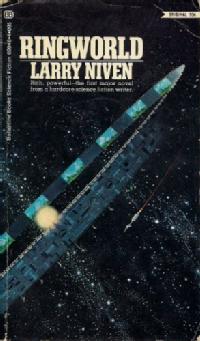 A solid shell of this kind is rather difficult to imagine from a technological perspective, and Dyson noted its technical difficulties, but he also proposed variants on the idea including swarms of smaller structures, networked around the primary star for energy capture and habitation. Perhaps more plausible than the shell (but still infinitely out of reach to us) are partial spheres in the form of equatorial rings, each rotating for self stabilisation, as famously shown in Larry Niven’s Ringworld series (novels, from 1970) , but similar (if smaller) rings appear for example in the Orbitals of Iain Banks’ novel series describing The Culture (1987-2012) which have diameters of order 1-10 million kilometres. These orbit their sun rather than surrounding it, but face similar technical challenges and provide similar advantages.
A solid shell of this kind is rather difficult to imagine from a technological perspective, and Dyson noted its technical difficulties, but he also proposed variants on the idea including swarms of smaller structures, networked around the primary star for energy capture and habitation. Perhaps more plausible than the shell (but still infinitely out of reach to us) are partial spheres in the form of equatorial rings, each rotating for self stabilisation, as famously shown in Larry Niven’s Ringworld series (novels, from 1970) , but similar (if smaller) rings appear for example in the Orbitals of Iain Banks’ novel series describing The Culture (1987-2012) which have diameters of order 1-10 million kilometres. These orbit their sun rather than surrounding it, but face similar technical challenges and provide similar advantages.
The Dyson sphere in Bowl of Heaven (novel, 2012) and its sequel Shipstar (novel, 2014) by Gregory Benford and Larry Niven [6] is also incomplete, but less so than a ring. Instead, one side of the sphere is left open to allow sunlight to escape while the other forms a mirrored bowl to capture and reflect it back to the primary. The light is focused to form a hot spot on the sun and the resultant flaring is focused into a jet and acts as a source of force which pushes the bowl and star through space together. This forms what is known as a Shkadov thruster, a type of stellar engine which awes the human explorers who discover it. As they excitedly describe it:
"A wok with a neon jet shooting out the back... and living room on the inside, more territory than you could get on the planets of a thousand solar systems. Pinned to it with centrifugal grav..."
"They don't live on the whole bowl. Just the rim. Most of it is just mirrors. Even so it's more than a habitat," said Cliff. "It's accelerating. That jet! This whole thing is going somewhere. A ship that is a star. A ship star. We humans only built a star ship." (2014 Titan books edition, pg 62)
This semi-sphere isn't a paradise however. The bird-like native population of this sphere inhabit a broad habitable band around the system's equator, where the rotating bowl provides near-Earthlike gravity. They also populate it with "Adopted" sentient races picked up from planets and modified as servitors - whether they want to be or not. For the human crew, the awe of the discovery is soon confronted with the realities of survival.
By contrast, some authors have considered resculpting solar systems but rejected the idea of spherical or ring structures entirely. The vast spaceship Marrow in Robert Reed’s 2000 novel of the same name is a solid cylinder (rather than hollow tube) large enough to conceal an entire Earth-like planet at its core, and would have required the dismantling of several planets to construct, but does not rotate to produce artificial gravity. Its purpose and construction, like those of so many other megastructures in science fiction, are secrets long since lost by the time humans and others occupy a fraction of its volume.
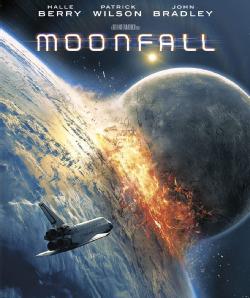 An entirely less plausible megastructure based on a Dyson sphere can be found in the 2022 film Moonfall. Here self-dubbed megastructurist K C Houseman finds his theories vindicated when the orbit of Earth’s moon begins to decrease, with the satellite spiralling towards the ground. Pointing out how unusual the Moon’s size is relative to the Earth, the film argues that the Moon is in fact a mini Dyson sphere constructed around a white dwarf star and filled with alien technology (complete with spinning ring structures) which led to the evolution of life on Earth. There are so many things wrong with this film (scientifically and otherwise) that it’s impossible to unpack them here, but we’ll start with the fact that no white dwarf low enough in mass to fit inside the moon could have evolved naturally in the lifetime of the Universe, continue with concerns about conservation of energy and the Moon’s observed surface temperature, and finish with a despairing shake of the head at the idea that the moon’s mass could fluctuate as described.
An entirely less plausible megastructure based on a Dyson sphere can be found in the 2022 film Moonfall. Here self-dubbed megastructurist K C Houseman finds his theories vindicated when the orbit of Earth’s moon begins to decrease, with the satellite spiralling towards the ground. Pointing out how unusual the Moon’s size is relative to the Earth, the film argues that the Moon is in fact a mini Dyson sphere constructed around a white dwarf star and filled with alien technology (complete with spinning ring structures) which led to the evolution of life on Earth. There are so many things wrong with this film (scientifically and otherwise) that it’s impossible to unpack them here, but we’ll start with the fact that no white dwarf low enough in mass to fit inside the moon could have evolved naturally in the lifetime of the Universe, continue with concerns about conservation of energy and the Moon’s observed surface temperature, and finish with a despairing shake of the head at the idea that the moon’s mass could fluctuate as described.
Big Dumb Objects?
Early science fiction commentators once dubbed megastructures Big Dumb Objects (or BDOs) as they appeared purely as plot devices without any consideration of physical plausibility. Later writers of hard science fiction insisted that they wrote of Big Smart Objects instead, having given serious thought to the unobtainable materials required to their construction and their energy requirements [7]. All such fiction remains highly speculative, but, nonetheless, megastructures continue to exert a firm hold over the popular imagination, and also to be the subject of genuine scientific investigation. Dyson’s original paper regarding the spherical structures that came to be named after him was a proposal that the infrared emission expected from megastructures could be detectable in astronomical surveys. This idea has not vanished. Astronomer Duncan Forgan, for example, proposed in 2013 that the current generation of exoplanet searches could be sensitive to a range of structures including Shkadov thrusters, while Jacob Haqq-Misra and colleagues have recently described searches for a range of similar megastructure technosignatures. As always, however, a limiting factor in searching for signs of artificial structure is the unpredictability of purely natural phenomena, and the subsequent difficulty in distinguishing them from those generated as a result of conscious actions. A star observed by the Kepler mission, for example, showed a series of very unexpected fluctuations in its light. KIC 8462852, nicknamed Tabby’s Star after the researcher who first described it scientifically, was proposed as a megastructure due to astronomers’ difficulty in explaining the light curve. However, unsurprisingly, it now appears that relatively common stellar and circumstellar dust could well explain the data without invoking such an unlikely cause. As was the case here, any future great claim of a megastructure discovery will also carry with it a great burden of responsibility on the discoverer to rule out more plausible explanations.
The appearance of megastructures in fiction perhaps says more about humanity’s constant desire to build bigger (and consume more resources) whenever possible, than about what we might find in the wider Universe. City-sized vehicles and arcologies may be technologically within our grasp, and speak to our aspirations for our own civilisation, but their absence from our landscapes betray some of their substantial drawbacks.
Any true megastructure construction would require vast-scale collection and modification of materials, assuming adequate materials for some of the larger constructs can be found to exist rather than simply falling into the category of unobtainium. It would represent a colossal investment of time, labour, material and energy. It would also likely represent a colossal degree of destruction of existing bodies and environments. In a world facing material and energy shortages, and increasingly recognising the importance of hitherto-disregarded natural resources, processes and systems, we might reasonably question who has a right to advance plans for such conspicuous consumption, and who gets to make that decision. While the hypothetical goal of most constructs in SF is to increase living spaces and the quality of life of the constructors, fiction points out just how often they might fail to reap the expected benefits, or others might suffer for their decision. It also assumes that the priorities and decisions of alien civilisations will mirror those of humanity. Whether alien civilisations experience the same drives, or, of course, whether they even exist, remains to be seen.
SF megastructures provide some of the most visually impactful and intellectually interesting settings against which narratives can play out. They also, as always, represent a logical extrapolation of our own technologies and a reflection of our desire for longer, higher and faster in all contexts. When set against the cosmic size and timescales of our Universe, humanity can seem very small indeed. Perhaps, in fiction of megastructures, we see a way to set our stamp on a big Universe, and assert - in the most strident possible way - that we are here!
“Megastructures”, Elizabeth Stanway, Cosmic Stories blog, 21st May 2023.
Notes:
[1] Other moving cities in science fiction include the Cities in Flight of James Blish’s novel series, starting with They Shall Have Stars (1956). Here a device is used to generate a forcefield around an entire city, lifting a chunk of the ground on which it sits and allowing it to travel through space. However these are perhaps more akin to asteroid-mounted civilisations than single-structure city structures. [Return to text]
[2] Space ships in science fiction vary enormously in size, with some appearing in computer games and in novels such as Frank Herbert’s Dune (1965) extending close to 20 kilometres in size as this fantastic graphic by artist Dirk Loechel illustrates. [Return to text]
[3] The size of the Trig is never quantified. The Big Finish Tomorrow People audio drama "Trigonometry" (2005) placed the Trig “in synchronous orbit on the dark side of the Moon” - a wildly unphysical placement which suggests it’s a bit smaller in this variant of the universe than it appears in other contexts from those seen on screen in the original television series. [Return to text]
[4] The capacity of a civilisation to make use of the energy available to it is measured on the Kardashev scale. A Dyson sphere would be the product of a Type II civilisation. Humanity has not yet reached Type I, with some estimates placing us at about 0.7. A Type III civilisation would control the energy of an entire galaxy. [Return to text]
[5] These also include the Dyson Sphere located by the USS Enterprise-D in Star Trek: The Next Generation episode “Relics” (1992, together with its sequel novel “ST:TNG Dyson Sphere” by Pellegrino and Zebrowsky, 1999), and the Worldsphere (introduced in The Also People, Ben Aaronovitch, 1995) inhabited by the two trillion People in the Doctor Who spin out novels The New Adventures. [Return to text]
[6] Astute readers will have noticed the recurrence of Larry Niven's writings in this list. Megastructures clearly fascinated the author, and he returned to these themes time and again with a range of coauthors as well as in his own writing. [Return to text]
[7] Benford and Niven wrote an appendix to their Shipstar which discussed Big Smart Objects and their design for the Bowl in detail. [Return to text]
All images have been sourced online. They are used without permission but for academic commentary and criticism. All opinions and ideas expressed are the writer's own and do not necessarily reflect those of the University of Warwick.
